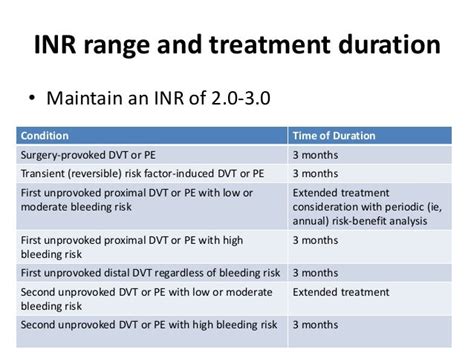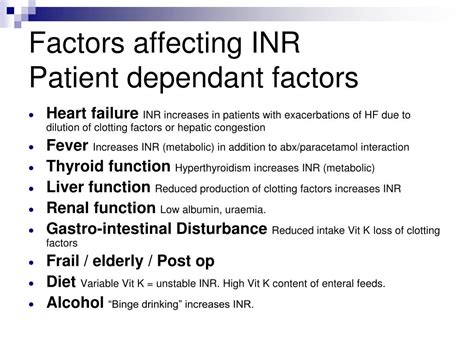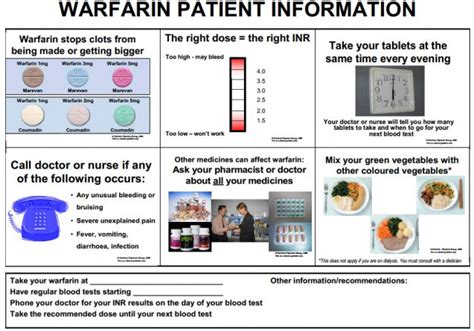Intro
The Internationalized Normalized Ratio, commonly referred to as INR, is a crucial metric used to measure the time it takes for blood to clot. It is primarily used to monitor patients who are taking warfarin, a blood-thinning medication that is often prescribed to prevent blood clots from forming. The INR test is essential in ensuring that patients are within the optimal therapeutic range, which helps to minimize the risk of bleeding or clotting.
The importance of INR cannot be overstated, as it plays a critical role in the management of various medical conditions, including atrial fibrillation, deep vein thrombosis, and pulmonary embolism. By regularly monitoring INR levels, healthcare professionals can adjust the dosage of warfarin to ensure that patients receive the most effective treatment while minimizing the risk of adverse effects. In this article, we will delve into the world of INR, exploring its significance, working mechanisms, and the steps involved in maintaining optimal INR levels.
The concept of INR is closely tied to the prothrombin time (PT) test, which measures the time it takes for blood to clot. The PT test is used to evaluate the extrinsic and common coagulation pathways, and the results are expressed in seconds. The INR is then calculated by comparing the patient's PT result to a standard reference range, which is usually established using a control sample. This calculation helps to standardize the results, allowing healthcare professionals to compare INR values across different laboratories and patients.
Introduction to INR

The INR test is a vital tool in the management of warfarin therapy, as it helps to ensure that patients are within the optimal therapeutic range. The therapeutic range is typically between 2.0 and 3.0, although this may vary depending on the individual patient's condition and the specific medication being used. By regularly monitoring INR levels, healthcare professionals can adjust the dosage of warfarin to maintain optimal anticoagulation, reducing the risk of bleeding or clotting.
How INR Works
The INR test works by measuring the time it takes for blood to clot, which is affected by the presence of warfarin. Warfarin works by inhibiting the production of vitamin K-dependent clotting factors, which are essential for blood coagulation. By reducing the production of these clotting factors, warfarin increases the time it takes for blood to clot, thereby reducing the risk of blood clots. The INR test measures the effect of warfarin on blood coagulation, allowing healthcare professionals to adjust the dosage to achieve optimal anticoagulation.Benefits of INR

The benefits of INR are numerous, and it plays a critical role in the management of various medical conditions. Some of the key benefits of INR include:
- Reduced risk of bleeding: By monitoring INR levels, healthcare professionals can adjust the dosage of warfarin to minimize the risk of bleeding.
- Reduced risk of clotting: INR helps to ensure that patients are within the optimal therapeutic range, reducing the risk of blood clots.
- Improved patient outcomes: By maintaining optimal INR levels, patients are less likely to experience adverse effects, such as bleeding or clotting.
- Enhanced patient safety: INR monitoring helps to identify potential issues before they become major problems, ensuring that patients receive the most effective treatment while minimizing the risk of adverse effects.
Steps Involved in Maintaining Optimal INR Levels
Maintaining optimal INR levels requires careful monitoring and adjustment of warfarin dosage. The steps involved in maintaining optimal INR levels include:- Regular INR testing: Patients should undergo regular INR testing to monitor their blood clotting time.
- Warfarin dosage adjustment: Based on the INR results, healthcare professionals can adjust the dosage of warfarin to maintain optimal anticoagulation.
- Lifestyle modifications: Patients can make lifestyle modifications, such as avoiding certain foods or activities, to minimize the risk of bleeding or clotting.
- Patient education: Patients should be educated on the importance of INR monitoring and the steps they can take to maintain optimal INR levels.
Factors That Affect INR

Several factors can affect INR levels, including:
- Diet: Certain foods, such as leafy greens, can affect INR levels.
- Medications: Other medications, such as antibiotics, can interact with warfarin and affect INR levels.
- Lifestyle: Lifestyle factors, such as smoking or exercise, can affect INR levels.
- Medical conditions: Certain medical conditions, such as kidney or liver disease, can affect INR levels.
Common INR-Related Issues
Some common INR-related issues include:- Bleeding: Patients with high INR levels may be at risk of bleeding.
- Clotting: Patients with low INR levels may be at risk of clotting.
- Warfarin resistance: Some patients may develop resistance to warfarin, making it challenging to maintain optimal INR levels.
- INR variability: INR levels can fluctuate over time, making it essential to regularly monitor INR levels.
INR Monitoring Devices

INR monitoring devices are essential for patients who are taking warfarin. These devices allow patients to monitor their INR levels at home, reducing the need for frequent laboratory visits. Some common INR monitoring devices include:
- Point-of-care INR devices: These devices use a small blood sample to measure INR levels.
- Home INR monitoring devices: These devices allow patients to monitor their INR levels at home, using a small blood sample.
- Laboratory-based INR testing: This involves sending a blood sample to a laboratory for INR testing.
INR Target Range
The INR target range varies depending on the individual patient's condition and the specific medication being used. The therapeutic range is typically between 2.0 and 3.0, although this may vary. Some common INR target ranges include:- Atrial fibrillation: 2.0-3.0
- Deep vein thrombosis: 2.0-3.0
- Pulmonary embolism: 2.0-3.0
INR and Patient Education

Patient education is essential for patients who are taking warfarin. Patients should be educated on the importance of INR monitoring and the steps they can take to maintain optimal INR levels. Some key points to include in patient education include:
- The importance of regular INR testing
- The risks and benefits of warfarin therapy
- Lifestyle modifications to minimize the risk of bleeding or clotting
- The importance of adhering to the prescribed warfarin dosage
INR and Healthcare Professionals
Healthcare professionals play a critical role in INR monitoring and management. They should be educated on the importance of INR monitoring and the steps involved in maintaining optimal INR levels. Some key points to include in healthcare professional education include:- The importance of regular INR testing
- The risks and benefits of warfarin therapy
- The steps involved in adjusting warfarin dosage
- The importance of patient education and adherence to the prescribed warfarin dosage
What is INR?
+INR stands for Internationalized Normalized Ratio, which is a test used to measure the time it takes for blood to clot.
Why is INR important?
+INR is important because it helps to monitor patients who are taking warfarin, a blood-thinning medication, to prevent blood clots from forming.
What is the therapeutic range for INR?
+The therapeutic range for INR is typically between 2.0 and 3.0, although this may vary depending on the individual patient's condition and the specific medication being used.
In conclusion, INR is a critical metric used to measure the time it takes for blood to clot, and it plays a vital role in the management of various medical conditions. By understanding the importance of INR, the benefits of INR monitoring, and the steps involved in maintaining optimal INR levels, patients and healthcare professionals can work together to minimize the risk of bleeding or clotting. We encourage readers to share their experiences with INR monitoring and to ask questions in the comments section below. Additionally, we invite readers to explore other resources on INR and warfarin therapy to further enhance their understanding of this critical topic.
